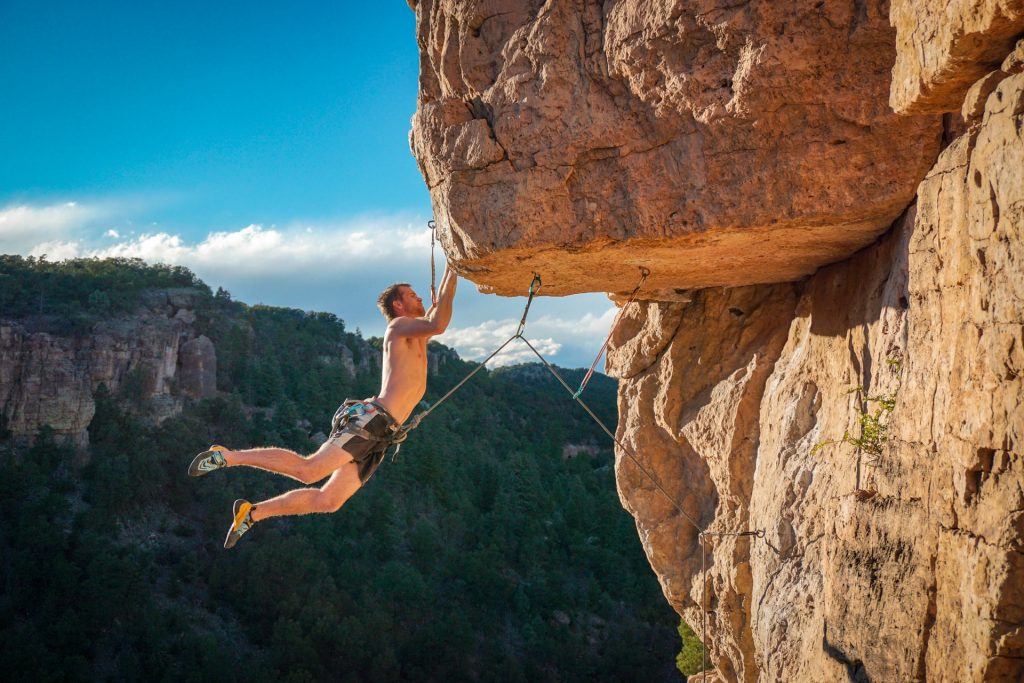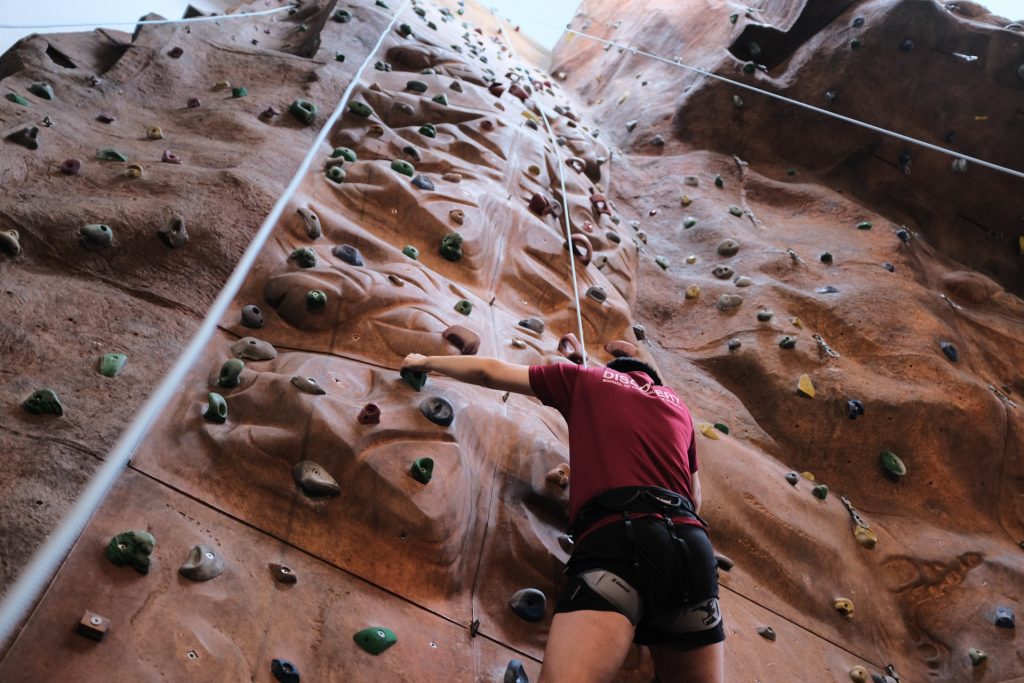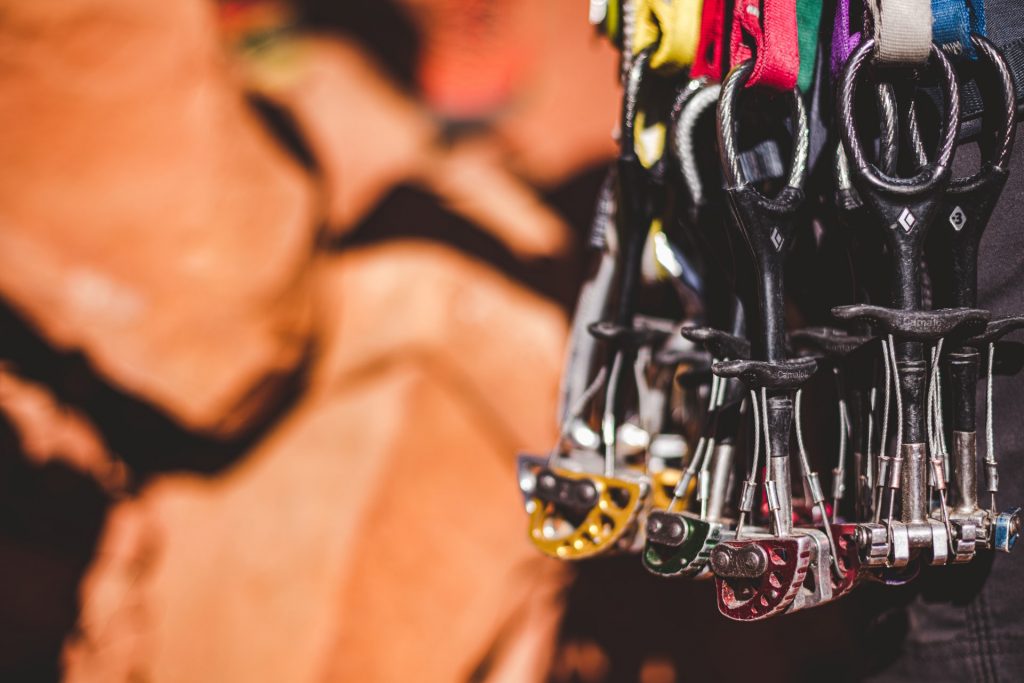Table of Contents
What Is Trad Climbing?
Trad climbing is a type of climbing that feels like an adventure. You and your buddy tackle a wall using solely technique, equipment, and expertise. The danger is serious, and you must make every decision. Although sport climbing is undoubtedly the most popular type of climbing today.
Trad climbing, also known as traditional climbing, is where the current pattern began. While you may start to top rope and lead in a gym before venturing out, Trad climbing allows you to climb wherever you want – without the constraints of bolts.
Trad climbing is a more traditional kind of rock climbing in which the climber places protection against falling into the wall. As a climber ascends, they insert pieces of gear – like cams or nuts – into rock faults, then clip their rope into carabiners that are also attached to the gear.
If a climber falls, the gear they’ve installed should keep them safe, and the companion below should catch their drop on the rope. For Trad, this involves knowing how and when to place gear, as well as knowing what kind you’ll need. Learning Trad takes time and guidance from people with experience, much like an apprenticeship.
Is Trad Climbing Safe?

Because the gear is not stable and can slip if put incorrectly, traditional climbing is riskier than sports climbing. Furthermore, one can only install protection where the rock allows it, so there are frequently enormous, dangerous runouts between pieces.
Climbing involves both moderate and overwhelming risks. A climber, for example, can avoid falling by using a belay and placing a stopper knot at the end of a rope; but there is always the remote possibility that a jagged boulder will fall and cut that line. Many of the inherent threats, fortunately, may be addressed through appropriate risk management procedures.
Climbing is inherently dangerous. Bouldering is also perilous since every fall means hitting the ground. While many people believe that because there are no bolts, trad climbing is more dangerous than sports climbing, it’s crucial to remember that climbing gear was not the only thing that keeps you safe! Poor rock quality, risks on the wall, and lowering/rappelling miscommunications can all happen on a sports climb just as easily as on a trad climb.
This is not to say that trad climbing is always more dangerous than sport climbing; ascending a 5.6 trad route with bomber gear placement is unquestionably safer than ascending a 5.11 X sport route with runout bolts and loose anchors. A skilled and diligent trad climber is less likely to be injured than a novice (or drunk) sport climber. However, an equivalent sports route is often safer than a traditional route.
How do you start trad climbing?

Hiring a tour guide who can devote their time to trying to make sure you master a wide range of abilities is the best approach to get started with Trad climbing.
They can personalize your encounter to the area, determine everything you need to listen to the most, and have a variety of equipment to give you a feel. Following that, spending time with reliable and knowledgeable locals is an excellent approach to expanding your expertise
There is a strong tradition of mentoring in Trad climbing, and everyone has something to give to your developing repertoire of Trad skills.
Leading and Following In Trad climbing
In Trad, the lead climber is the one who goes first and places the gear. The next is the climber who follows them up, typically while still being belayed from the above. Next remove the gear, often known as “cleaning” the route. In most cases, leading a route is scarier than seconding.
but seconding is a terrific opportunity to learn about equipment placement while getting some climbing in. Removing installed gears is a skill in and of itself, particularly when cams are “over-cammed” – the lobes are overly tight and the cam has little room to expand. Taking a tumble or pulling too strongly on a nut is also a good way to permanently fuse it in place.
Know Your Pro Before You Climb
Before you head out to the hills with your new hexes, nuts, and camming gadgets, be sure you understand how they function. It is critical that you find an expert trainer and learn how to build secure anchors and place protection. Invest spending time in the field first. Go to the base of a cliff and work out how to fit wedges, cams, and hexes into the various rock features.
Then try several short, simple pitches with a range of parts, not only spring-loaded camming devices, which are the easiest to the position. It’s not the best time to be struggling with your rack, trying to figure out how to put pro while hanging on a rock face with three fingers and a couple of toes 60 feet above the deck.
The Climbing Gear you need to get started trad climbing

“Trad is rad,” as it has been remarked countless times. However, determining what you’ll need to get started with traditional (or “trad”) climbing might be challenging. Trad climbing necessitates a little more equipment than other sports, but that should not deter you. You don’t have to buy everything at once if you’re just beginning off. With that in mind, we’ve created this checklist to help you get started on your multi-pitch outfit and get out there.
Climbing Harness
A rack of gear must be carried by a traditional climbing harness. It’s nice to have a comfy harness to hang about in, especially on longer routes or those with hanging belays. Aspiring trad climbers must pick a harness that allows them to rack their gear while being comfortable. An all-around version with spur gears loops on each side is a good place to start. These have ample padding for all-day comfort and enough gear loops to hold all of the gear required for a multi-pitch climb.
Learn more about the: kids Climbing Harness for Excellent Support
Climbing Shoes
Climbing shoes designed for multi-pitch trad climbing are more ergonomically designed and have a wider fit than those designed for other climbing disciplines. Beginner trad climbers should avoid the pointed toes and severe downturns found in many of today’s sport climbing and bouldering shoes, instead opting for a shoe that can be pushed into crevices, splattered on slabs, and, most importantly, worn for long periods of time.
Learn more about the: Best Trad Climbing Shoes
Climbing Helmet
If you’re considering trad climbing, you should bring a helmet with you. Your head is constantly in peril, whether it’s from others going above you, gear management, the rare loose rock, or exposure. Today’s are lightweight, comfortable, and reasonably priced. Purchase one before heading out to the crag to protect your head and prevent appearing inexperienced.
Nut Tool
A nut (or chockstone) is a metallic wedge strung on a cable that climbers use to protect themselves by wedging it into a fissure in the rock. Ascending climbers connect quickdraws to the nut wire and the cable thread through the quickdraw. Nuts come in a range of sizes and designs, and competing manufacturers produce several different brands. Aluminum is used to make the majority of nuts. Larger nuts can be placed on the Dyneema cord rather than wire, but this is becoming uncommon.
Rope
Climbing ropes are meant to keep you secure in a variety of scenarios. It’s crucial to understand exactly how climbing ropes function, as well as the various types, lengths, and treatments available, as well as which ropes are most suited for which climbing methods. Ropes with a smaller diameter are often lightweight but less durable, whereas thicker ropes are heavy but will outlive their smaller counterparts. Because traditional climbing puts more strain on a rope, diameters of 9.8 mm and more are recommended.
Learn more about the: Rock Climbing Ropes
Carabiners
(Locking & Non-Locking)- Carabiners are to climbing what pawns are to chess – they’re not the fancy parts making all the flamboyant moves, but they’re crucial and must be used. Different carabiners serve different functions, and depending on what you’re climbing (and how), you’ll need a range of ‘biners. All of the gear in your rack must be clipped to your harness in some way. More is required for alpine draws, as well as locking carabiners for anchor construction and another for your belay device.
Slings
Whenever it comes to mountaineering equipment, slings are unquestionably the jack-of-all-trades. Climbers used to make their own slings out of webbing tied into a loop with a tape or water knot. Nowadays, the safer and more convenient option is to purchase a stitched sling that meets the EN 566:2006 standard. Slings are extremely versatile pieces of equipment that are typically made either from nylon or Dyneema webbing and sewed into a sturdy circular loop. Available in a range of lengths, 120cm is by far the most helpful, while longer and shorter lengths are equally handy.
Learn More About
Best Trad Climbing Destinations
Conclusion
While traditional climbing may be more dangerous than sport climbing, it leaves little or no trace of climbing, preserving the natural environment of the cliff face (though many significant first ascents in the United States were done with a combination of permanent anchors or bolts and crack-fitting hardware were labeled “traditional” when the term was first coined—see climbing styles). Climbing, on either hand, necessitates bolts being securely hammered into the rock face to serve as the sole or major source of protection. The distinction between sport and traditional or “trad” climbing approaches has sparked some dispute in the rock-climbing community as the opposing camps debate the benefits of the various styles.










Discussion about this post